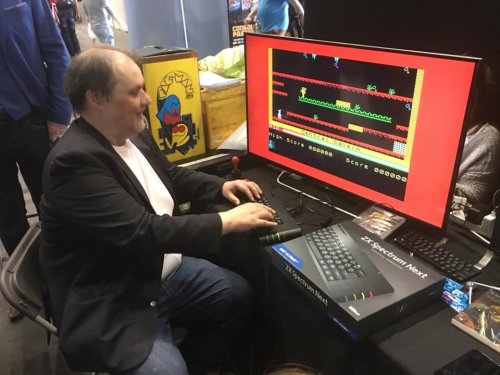Wally
Retired Admin
- Joined
- 19 Ιαν 2006
- Μηνύματα
- 25.959
- Αντιδράσεις
- 4.767
Μολις ανεβηκε στο Edge Online.Δεν προλαβα καν να την διαβασω!
Την ποσταρω και μιλαμε.
EDIT:Μαλλον ειναι καμια πενταετια πισω. Δεν πειραζει, ειναι o Matthew Smith!
Την ποσταρω και μιλαμε.
EDIT:Μαλλον ειναι καμια πενταετια πισω. Δεν πειραζει, ειναι o Matthew Smith!
ΠηγηMiner Willy is in The Bathroom. Heʼs drunk and desperate for sleep, but his tyrannical housekeeper, Maria, has barred the way to the Master Bedroom. Her foot taps judgementally and an outstretched arm commands her remorseful employer to clear up the debris of a debauched eveningʼs entertainment before slumber can carry him towards tomorrowʼs inevitable hangover. The party is definitely over.
Matthew Smith is in The Kitchen. We warm ourselves on this winter morning in his chilly house by the gas hob, before settling down in The Living Room to watch a DVD containing a playthrough of Jet Set Willy, Smithʼs ambitious follow-up to Manic Miner. He is going to talk us through the gameʼs creation.
“Yeah, I did The Bathroom and the Top Landing first and did most of the testing here,” Smith recalls.
“Making sure the stairs worked and the creatures moved OK.” He points to a Ladder Bug, a purple, gawping blob atop elongated legs, so dubbed because it evolved from the stepladders he drew for Manic Miner and smiles at the spinning Swiss Army knife, before exclaiming “Andre!” on entering The Kitchen, as if heʼs greeting an old friend. “Ah, heʼs from a little game I did for Computer & Video Games magazine – a type-in called Andreʼs Night Off,” Smith explains, the cleaver-brandishing mad chef being an amalgam of TV cooks at the time.
Willy traverses between the Back Stairway and Cold Store, in a section Smith based on the Wacky Amoebatrons cavern from Manic Miner, but split over two rooms. The screens flick instantly from one to another. “The code for Jet Set Willy was packed but not compressed,” explains Smith. “With Manic Miner it wasnʼt even packed – everything was in memory all the time, 1K for each screen – but with this I packed it into 256 bytes for each room. It was quick to decode. People are amazed I got so many screens in, but Jet Set Willy 2 had double the amount.”
Miner Willy is now scouring The Beach, avoiding partially buried crabs and happily discovering that the broken bottle he picks up is worth two items. Smith squints and shakes his head. “Christ, I must have put two on top of each other...” This momentary regret passes as Smith goes on to explain the swinging rope above Willyʼs head. “Itʼs my favourite bit of the game,” he beams, “the only thing I like more about JSW than Manic Miner. I had a table of numbers and Iʼd take a bit off each one to make it swing nice. But I ran out of numbers, so at the end it has this little kink. I wonʼt mess with that, I thought. I like the kink.”
Big smile, big exhale. Willy ventures on and is confronted by the Banyan Tree, a brutally difficult challenge, once considered impossible by many young gamers. Smith acknowledges it was ʽbloody trickyʼ and describes the ʽhold jump and squirt outʼ method, giving an insight into the playtesting process. “I tested every room to make sure you could complete it – and this one took me days – but once Iʼd proved any screen was possible, that was it. It was staying. Thatʼs why thereʼs no random numbers in JSW. Everything resets when you enter each screen, all the arrows enter from the same place at the same time and all the creatures move in the same pattern. That was important because of the way Iʼd done the collision detection – if anything collided on screen, you would die.”
The dynamic of designing, coding and testing had its own lolloping momentum. Smith would draw rooms by hand on large sheets of graph paper, six rooms to a page. (He actually hung on to these first drafts of the Frank Lloyd Wright-inspired mansion right up until the mid ʼ90s, despite his motherʼs dog having urinated on them during the previous decade.) He would then type the relevant numbers into a Tandy TRS-80 Model 4 and any actual coding was done on this machine, before being ʽsquirtedʼ, a favourite Smith phrase, on to the target machine: the Sinclair Spectrum.
“I got it down to one minute for a graphical change and two minutes if I was changing a line of code and it needed assembling,” Smith recalls with pride. “Then Iʼd have a look on the Speccy to see if it worked and was worth keeping. Yeah, it was slow and it didnʼt help that I hadnʼt got an editor, like with Manic Miner. It did drag on and I was losing my patience...”
Unlike Smithʼs first bestseller, Manic Miner, which was created in a testosterone-sustained eight- week block of night-time coding at his motherʼs house in Wallasey, Merseyside, the development of its sequel took eight tortuous months. Smith had left previous publisher Bug Byte after becoming disgruntled with a lack of royalty payments due to him and had set up Software Projects with another former employee, Alan Maton. “I was still coding at my mumʼs house,” he remembers. “Even though I was a director of Software Projects, I didnʼt really go into the offices. Alan would come round most days and stand behind me. And poke me.”
Appropriately enough, Willy is now Up On The Battlements, a section of the mansion clearly inspired by arcade title Hunchback, avoiding a nasty prod from one of the guards. “Actually, thatʼs supposed to be Dave Ward,” says Smith, pointing to the particularly frantic sentries on the Rescue Esmeralda screen, before explaining how heʼd done a Pac- Man clone on the VIC-20 for Wardʼs short-lived Spectrum Games Limited publishing house, before he went on to found Ocean Software. Apparently, the sunglasses and mad professor hair tufts are a dead giveaway.
Willyʼs mansion was full of such nods to Smithʼs real-world experience. We Must Perform A Quirkafleeg alludes to his fondness for the Fabulous Furry Freak Brothers comics (and their herbs of choice) and Emergency Generator, complete with airborne pig, is an obvious homage to Pink Floydʼs Animals album cover. We wonder how pirouetting rabbits, wobbling jellies and the entire cast of inanimate objects brought disturbingly to life fitted into Smithʼs everyday existence. “That may have been the mushrooms,” he offers, helpfully.
Which may explain the undulating offspring of Centipede and Pac-Man which now faces Willy in The Attic. It marks a far greater terror, though – the infamous Attic Bug. “Thereʼs no error checking in the code, so all the data has to be perfect,” confesses Smith. “Thereʼs 60 rooms, but memory for 64 and I just couldnʼt get the last few working.
I think the problem was the hard disc driver on the Tandy was loading into high memory, even though the manual said it was supposed to load into low memory, and that was writing over those last four rooms. It was three days before it was going to the duplicators and I thought 60 rooms was three times as many as Manic Miner, so just left them out, but you can jump into one of the ʽdead roomsʼ accidentally. Itʼs somewhere off the Mega Tree [smith makes a vague hand gesture over to the right] and I think an arrow fires offscreen or something and then fucks things up if you go to The Attic afterwards. Iʼm sorry, I didnʼt bother chasing it down too hard... it was just so near the end.”
The ʽdead roomsʼ are not to be confused with the ʽdeath roomʼ, the Entrance To Hades screen, which inquisitive players can stumble upon only to find all of their lives swiftly evaporating. The numerous satanic visages, based on Iron Maidenʼs beast mascot Eddie, are balanced with a selection of religious imagery, though, in The Chapel, The Forgotten Abbey and Priestsʼ Hole. “Brideshead Revisited had been on that year and it coloured my notion of what a country house should contain,” adds Smith.
As Willy heads up the Mega Tree, an idea that would grow into a future (unfinished) Smith project, we admire the foliage strewn across Out On A Limb. “I call myself an impressionist,” Smith states proudly. “I donʼt think anyone could represent anything in 8bit like I could. Thatʼs the secret of my success... I should be doing sprites for phone games, not mucking about with 3D!” He picks up the nearby N-Gage hopefully, before cursing its dead SIM card.
The item count reads 82 and so Willy heads for the final barrier – The Nightmare Room. Confronted by multiple incarnations of his nemesis Maria (based on a Greek woman who lived across the road from his mum, according to Smith) and a Pythonesque giant foot, Willy is unexpectedly metamorphosed into a flying pig.
“I just thought it was funny,” says Smith. “The pig was drawn so it was exactly the same height and width as Willy at the crucial moments. All the collision detection was properly bitmapped – you could get a bit of colour clash at times, but you only died if the pixels touched.”
And so with the epic journey complete, Willy enters his Master Bedroom, Maria no longer barring the entrance, only to realise his stomach can no longer contain the amount of alcohol consumed and makes a final mad dash to The Bathroom. “Yeah, I suppose that was the end of a lot of my evenings back then,” smiles Smith, as we watch poor Willy with his head firmly thrust down the toilet, his legs protruding from the bowl, kicking wildly. “And look, the chain is even flushing!”


